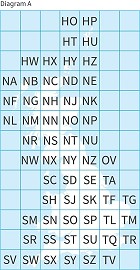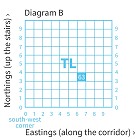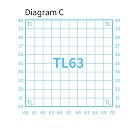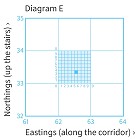A Beginner's Guide to Grid References
This quick and easy beginners' guide from the Ordnance Survey explains the National Grid, and the principles of how to read a simple grid reference. Just remember... along the corridor, then up the stairs.
Using the National Grid
You might have noticed by now that OS maps are covered in a series of blue grid lines.
These grid lines help you to pinpoint an exact location anywhere on the map.
The vertical lines are called 'eastings', as they increase in value as you travel east on the map.
The horizontal lines are called 'northings' as they increase in value as you travel north on the map.
These are linked to the National Grid which provides a unique reference system, and can be applied to all OS maps of Great Britain, at all scales.
Great Britain is covered by grid squares measuring 100 kilometres across and each grid square is identified by two letters, as shown in diagram A.
On OS maps, these squares are further divided into smaller squares by grid lines representing 10 kilometre spacing, each numbered from 0 to 9 from the south west corner, in an easterly (left to right) and northerly (upwards) direction.
You can see this in diagram B.
Using this system you can identify a 10 kilometre grid square.
For example, the above image shows TL63. After the letters you can quote the eastings (6) first, then the northings (3).
Top Tip: If you have trouble remembering the order, say… along the corridor, THEN up the stairs.
How do grid references help me find places?
It is easy to find a particular place using a grid reference.
To start, a four-figure grid reference is a handy way of identifying any square on a map.
Grid references are easy if you can remember that you always have to go along the corridor before you go up the stairs.
To find the number of a square first use the eastings to go along the corridor until you come to the bottom left-hand corner of the square you want.
Write this two-figure number down.
Then use the northing to go up the stairs until you find the same corner.
Put this two‑figure number after your first one and you now have the four-figure grid reference, which looks like the example in diagram D: 6233.
Six-figure grid references
If you want to pinpoint a more exact place on a map, such as your own house, you will need to use a six-figure grid reference.
First find the four-figure grid reference for the square and write it down with a space after each set of numbers, like this: 62_ 33_
Now imagine this square is divided up into 100 tiny squares with 10 squares along each side.
Still remembering to go along the corridor and up the stairs, work out the extra numbers you need and put them into your four-figure grid reference like this in diagram E: 625 333.
Top tip: When giving directions you can provide even more accuracy to your grid reference by stating a nearby landmark or feature. For example, on the Bembridge OS Explorer map I am at grid reference SZ 644 874, at the crossroads.
This article is reproduced with the kind permission of the Ordnance Survey as part of National Map Reading Week, 17-23 October, which encourages everyone to improve their map reading skills and discover new adventures.
For more information on National Map Reading Week, including a number of other map skills articles, see here
The OS have also recently launched the Great British Colouring Map. The first colouring book based on official OS maps, it has 55 maps including iconic cities, tourist spots and historic locations across England, Scotland and Wales plus a huge double size fold out map of central London and the Thames. It is printed on heavyweight paper suitable for both pencil and ink. It's available here





